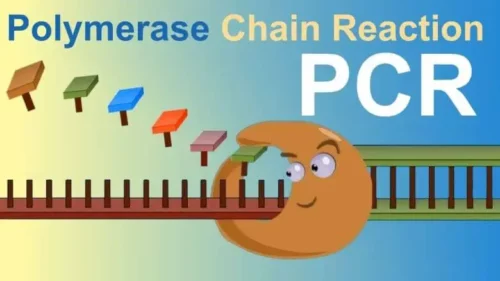Overview
Polymerase Chain Reaction, or PCR, is a transformative molecular biology technique with the prowess to amplify and analyze DNA segments. Through a precisely orchestrated cycle of denaturation, annealing, and extension, PCR exponentially replicates targeted DNA regions. This process is powered by a heat-stable DNA polymerase enzyme, originally extracted from thermophilic bacteria. PCR’s applications span diverse fields, encompassing genetic research, diagnostics, forensics, and more. By facilitating the rapid generation of ample DNA copies from minute samples, PCR has revolutionized genetic analysis, enabling researchers to scrutinize genes, identify pathogens, and unravel intricate genetic mysteries with unprecedented precision.
Know further about this article “PCR Full Form: Principles, Types, Advantages and more” below.



Principles of PCR
| PCR Principle | Description |
|---|---|
| Denaturation | Double-stranded DNA is heated to separate into single strands. Hydrogen bonds between base pairs break. |
| Annealing | Temperature is lowered to allow DNA primers to bind to complementary sequences flanking the target region. |
| Extension | Heat-stable DNA polymerase synthesizes a complementary DNA strand using primed templates. |
| Amplification | The process of denaturation, annealing, and extension is repeated in cycles, resulting in exponential DNA replication. |
| Applications | PCR is utilized in genetics, diagnostics, forensics, and more, enabling precise analysis and manipulation of DNA. |
Types of PCR
- Standard PCR: The foundational technique, amplifying DNA segments. It involves denaturation, annealing, and extension steps. Used in diverse applications, from gene expression analysis to cloning.
- Reverse Transcription PCR (RT-PCR): Detects and quantifies RNA by first converting it into complementary DNA (cDNA) using reverse transcriptase enzyme. Valuable in studying gene expression and viral RNA.
- Quantitative PCR (qPCR): Measures DNA or cDNA in real-time as it’s amplified. Provides accurate quantification of initial DNA amounts. Essential for gene expression studies, viral load measurements, and detecting low-abundance sequences.
- Digital PCR: Divides a PCR reaction into numerous partitions, allowing absolute quantification of DNA molecules. Precise for rare mutation detection, copy number variation analysis, and absolute nucleic acid quantification.
- Nested PCR: Involves two successive PCR reactions. The first amplifies a broad target region, and the second uses internal primers to amplify a smaller, specific fragment. Enhances specificity and sensitivity.
- Multiplex PCR: Amplifies multiple target sequences in a single reaction by using multiple primer pairs. Valuable for simultaneously detecting various pathogens or genes.
- Hot Start PCR: Utilizes modified DNA polymerases that are inactive at room temperature, preventing non-specific amplification during reaction setup. Enhances specificity and yield.
- Long Range PCR: Engineered DNA polymerases and reaction conditions enable amplification of longer DNA fragments, crucial for genomic studies, including whole-genome sequencing.
- Inverse PCR: Amplifies unknown DNA flanking a known sequence. Useful for identifying insertion sites, mutations, or rearrangements in genomes.
- Assembly PCR: Creates DNA constructs by amplifying overlapping fragments, allowing seamless fusion of DNA segments. Essential in gene synthesis and molecular cloning.
- Allele-Specific PCR: Discriminates between closely related alleles based on sequence differences. Used for genotyping single nucleotide polymorphisms (SNPs).
- Colony PCR: Rapidly screens bacterial colonies for the presence of inserted DNA. Saves time and resources during cloning experiments.
Advantages
| Advantages of PCR | Description |
|---|---|
| Amplification Precision | Exponentially amplifies specific DNA segments, aiding in studying rare sequences and degraded samples. |
| Rapid DNA Replication | Swiftly generates numerous DNA copies within hours, revolutionizing cloning and sequence analysis. |
| Diagnostic Versatility | Detects pathogens, mutations, and gene expression patterns, crucial in disease diagnosis and prognosis. |
| High Sensitivity | Amplifies low-abundance DNA, enabling detection of minimal target amounts, essential for diagnostics. |
| Specificity | Ensures selective amplification of desired DNA via specific primer binding, minimizing false positives. |
| Genetic Manipulation | Facilitates gene cloning, mutagenesis, and sequencing, advancing genetic engineering and synthetic biology. |
| Minimal Sample Requirement | Efficiently works with limited DNA samples, conserving resources and enabling analysis of trace amounts. |
| Quantitative Analysis | Real-time quantification with qPCR enables accurate gene expression measurement and viral load quantification. |
Disadvantages
| Disadvantages of PCR | Description |
|---|---|
| Susceptibility to Contamination | PCR is highly sensitive, making it prone to contamination from external DNA, leading to false results. |
| Amplicon Length Limitations | Longer DNA sequences can be challenging to amplify accurately due to polymerase errors and efficiency. |
| Primer Design Complexity | Inaccurate primer design can yield nonspecific amplification, demanding careful design and testing. |
| Inhibitory Substances | Inhibitors present in complex samples can hinder DNA amplification, necessitating purification steps. |
| Mutation and Error Accumulation | DNA polymerase errors during amplification can introduce mutations, potentially affecting results. |
| Template Degradation | DNA degradation prior to PCR can lead to unreliable results, demanding optimal sample handling. |
| Quantification Challenges | Absolute quantification can be challenging due to factors like PCR efficiency variations and bias. |
| Allelic Dropout | In allele-specific PCR, one allele may be preferentially amplified, leading to allelic dropout. |
Future Trends
- Digital PCR Advancements: Further refinements in digital PCR technology are expected, enhancing its precision and enabling absolute quantification of nucleic acids with even greater accuracy.
- Single-Cell PCR: PCR techniques tailored for single-cell analysis will gain prominence, allowing researchers to dissect cellular heterogeneity and understand complex biological systems at an unprecedented level.
- Point-of-Care Diagnostics: PCR platforms designed for rapid, on-site testing will continue to evolve, empowering healthcare professionals with quick and accurate diagnostic tools for various diseases.
- CRISPR-based PCR: Integration of PCR with CRISPR-Cas systems will enable targeted amplification and detection of specific DNA sequences, revolutionizing genome editing and diagnostics.
- Multiplexing Enhancements: Advances in multiplex PCR techniques will permit simultaneous amplification of numerous targets, enabling comprehensive genetic analysis and reducing time and resources.
- Miniaturization and Lab-on-a-Chip: PCR systems integrated into microfluidic devices will become more sophisticated, enabling portability, reduced reagent consumption, and high-throughput analysis.
- Quantitative and Digital Expression Analysis: PCR techniques will be harnessed for precise measurement of gene expression, facilitating deeper insights into cellular processes and disease mechanisms.
- Epigenetic PCR Applications: PCR-based methods will continue to be pivotal in studying epigenetic modifications, shedding light on gene regulation and heritable changes.
FAQs about PCR
PCR (polymerase chain reaction) tests are a fast, highly accurate way to diagnose certain infectious diseases and genetic changes. The tests work by finding the DNA or RNA of a pathogen (disease-causing organism) or abnormal cells in a sample.
Taq DNA polymerase is the most common enzyme used for PCR amplification. This enzyme is extremely heat resistant with a half-life of 40 minutes at 95°C. At its optimal temperature (72°C), nucleotides are incorporated at a rate of 2–4 kilobases per minute.
This means that the virus was not found in your sample. A negative PCR test result does not mean that you’ve never had COVID-19. It’s possible that you had the virus, but that: your immune system cleared it by the time you were tested. there was no virus present in the sample taken.
Each PCR cycle consists of template denaturation, primer annealing and primer extension. If the temperatures for annealing and extension are similar, these two processes can be combined. Each stage of the cycle must be optimized in terms of time and temperature for each template and primer pair combination.






